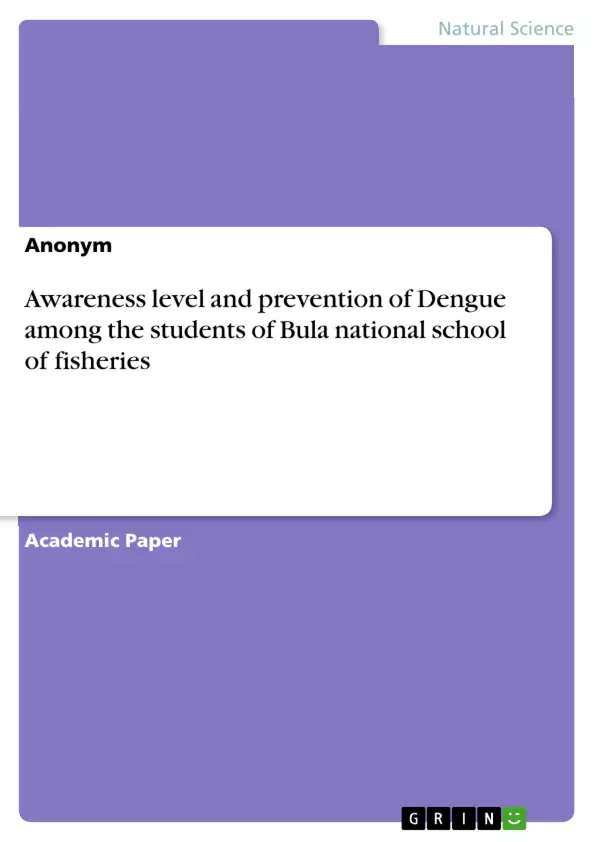This paper describe the demographic profile of the students and the level of Dengue awareness and prevention among them. It also determines the significant difference in the level of dengue awareness when classified according to gender, grade level, and socioeconomic status, and the significant relationship between the level of dengue awareness and the level of dengue prevention of students.
Dengue the mosquito borne disease is a growing health treat in a whole world. The lack of awareness and prevention in dengue can cause a lot of problems. This study used a descriptive normative survey and the use of simple random sampling to gain a lot of information from an individual or a group perspective. Results found that the distribution of respondents according to grade level and gender is widely from grade 6 and is mostly female. Also the students of BNSF have a moderate level of dengue awareness and prevention. Furthermore, there is no significant difference in level of awareness according to grade level, gender, or socioeconomic status.
The outcome also found that the relationship between the level of dengue awareness and the nature of illness, early symptoms and cause is not significant. These findings suggest that having a program like orientation and seminar can improve the students knowledge and awareness. Fogging and the use of insect repellent are effect ways to prevent dengue disease.
Inhaltsverzeichnis (Table of Contents)
- Abstract
- Acknowledgement
- Dedication
Zielsetzung und Themenschwerpunkte (Objectives and Key Themes)
The objective of this research is to assess the level of dengue awareness and prevention among students at Bula National School of Fisheries. The study aims to determine if there are significant differences in awareness based on gender, grade level, and socioeconomic status, and to explore the relationship between awareness and prevention practices.
- Level of dengue awareness among students.
- Effectiveness of dengue prevention methods.
- Influence of demographic factors (gender, grade level, socioeconomic status) on dengue awareness.
- Correlation between dengue awareness and prevention practices.
- Suggestions for improving dengue awareness and prevention.
Zusammenfassung der Kapitel (Chapter Summaries)
Abstract: This research paper investigates the demographic profile of students at Bula National School of Fisheries (BNSF) and their level of dengue awareness and prevention. It utilizes a descriptive normative survey with simple random sampling to gather data. The findings reveal a moderate level of dengue awareness and prevention among BNSF students, with no significant difference based on grade level, gender, or socioeconomic status. The relationship between awareness and understanding of the illness's nature, early symptoms, and causes was also found to be non-significant. The study suggests that programs such as orientations and seminars could enhance student knowledge, while fogging and insect repellent are effective prevention strategies.
Schlüsselwörter (Keywords)
Dengue awareness, dengue prevention, level of dengue awareness and prevention, student health, mosquito-borne disease, descriptive survey, public health.
Frequently Asked Questions: Dengue Awareness and Prevention Among Students at Bula National School of Fisheries
What is the main objective of this research?
The primary objective is to evaluate the level of dengue awareness and prevention among students at Bula National School of Fisheries (BNSF). It also aims to identify if awareness differs based on gender, grade level, and socioeconomic status, and to explore the connection between awareness and actual prevention practices.
What key themes are explored in this research?
Key themes include the level of dengue awareness among students, the effectiveness of dengue prevention methods, the influence of demographic factors (gender, grade level, socioeconomic status) on dengue awareness, the correlation between awareness and prevention practices, and suggestions for improving dengue awareness and prevention programs.
What methodology was used in this research?
The study employed a descriptive normative survey using simple random sampling to collect data from BNSF students.
What are the main findings of the research?
The research found a moderate level of dengue awareness and prevention among BNSF students. No significant differences in awareness were observed based on grade level, gender, or socioeconomic status. The relationship between awareness and understanding of the illness's nature, early symptoms, and causes was also found to be non-significant. The study suggests that educational programs like orientations and seminars could improve student knowledge, while fogging and insect repellent are effective prevention strategies.
What is included in the provided language preview?
The preview contains the title, table of contents, objectives and key themes, chapter summaries (including an abstract), and keywords.
What are the key demographic factors considered in the study?
The study considered gender, grade level, and socioeconomic status as key demographic factors influencing dengue awareness.
What suggestions were made for improving dengue awareness and prevention?
The study suggests implementing educational programs such as orientations and seminars to enhance student knowledge and understanding of dengue fever. It also highlights the effectiveness of fogging and insect repellent as prevention strategies.
What is the overall level of dengue awareness and prevention among the students?
The study revealed a moderate level of dengue awareness and prevention amongst the students.
What is the significance of the relationship between dengue awareness and prevention practices?
The study found no significant relationship between dengue awareness and understanding of the illness's nature, early symptoms, and causes. However, the effectiveness of prevention strategies like fogging and insect repellent were noted.
- Arbeit zitieren
- Anonym (Autor:in), 2023, Awareness level and prevention of Dengue among the students of Bula national school of fisheries, München, GRIN Verlag, https://www.grin.com/document/1450365



